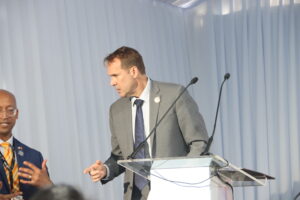They say change is the only constant in life. Well, I can confidently add one more thing to that list—diaper changes! Since the arrival of our twin grandchildren, Shekky and Shammy, our lives have been turned upside down in the most delightful way.
Becoming grandparents has been an adventure filled with laughter, surprises, and the occasional mystery of “Where did I put my glasses?” (Only to find them on my head). My wife and I have stepped into our new roles with the enthusiasm of first-time interns—only this time, we don’t get paid, and our bosses are less than a year old. We even have a new job titles: Chief Babysitters. A promotion we never applied for, but one we have come to love.

The Nature of Change: Babies vs. Adults
One thing I have learned is that babies are tiny, adorable agents of chaos. Their schedule? Unpredictable. Their decision-making process? Completely irrational. Their ability to resist change? Absolutely legendary.
Take, for instance, the day my ever-glowing, ever-energetic wife decided to buy Shekky and Shammy two new chairs. The idea was simple—help them transition from lying on their backs all day to sitting up like proper little humans. Logical, right? Wrong.
The twins revolted as if we had announced a nationwide ban on baby formula. They screamed, they squirmed, and they launched what can only be described as a full-scale rebellion. It took weeks before they grudgingly accepted their new thrones. And in that moment, it hit me—if babies resist change this much, what about adults?

This, my friends, is the essence of change management. Whether it is introducing a new system at work or convincing a toddler to eat vegetables, people (and tiny humans) do not like change. Let’s break it down:
The Five Stages of Change (as Demonstrated by Twin Toddlers)
1. Anticipation: The Calm Before the Storm
Before the twins were born, we were filled with joy and made all sorts of preparations—cot beds, clothes, and enough baby wipes and diapers to last a decade. In business, great leaders anticipate change, strategize, and make necessary preparations. The trick is realizing that no matter how much planning you do, reality will still throw surprises your way. (Like discovering at 3 AM that a baby’s diaper can defy the laws of physics.)
2. Resistance: The “Oh No, Not Happening” Phase
Resistance is a natural human (and baby) response. Shekky and Shammy resisted their chairs as if they were medieval torture devices. Employees resist new policies like they resist Monday mornings. The moment change is introduced, the first instinct is to say, “But we have always done it this way!” Change leaders must acknowledge that resistance is real—whether it’s coming from an employee or a baby flinging mashed bananas across the room.

3. Transition: The Battle Begins
This is where the real work happens. In our case, it meant weeks of cleverly sneaking the twins into their chairs, distracting them with toys, and using the classic “Look! A bird!” technique to make them forget their suffering. In organizations, this phase requires clear communication, training, and lots of patience. If you can survive this stage without losing your sanity (or getting hit in the face with a teething toy), you are on the right track.
4. Adaptation: The Light at the End of the Tunnel
One day, out of nowhere, Shekky and Shammy stopped resisting their chairs. It was as if they had forgotten why they hated them in the first place. In business, this is when employees start seeing the benefits of the new system. They won’t admit it, but suddenly, they realize, “Hey, maybe this is not so bad after all.” Leaders should celebrate small victories here—whether it’s an employee embracing new technology or a baby finally sitting in their chair without staging a protest.
5. Stabilization: The New Normal
Once the twins accepted their chairs, life became easier. In organizations, once people integrate change into their routines, it becomes second nature. However, this is also where complacency can creep in. Leaders must keep innovating to avoid slipping back into old habits—whether that means refining company processes or keeping up with a toddler’s ever-changing list of demands.

More from Africa News 24
The ghetto leadership story – By Ted Msipa (PhD)
Final Thoughts: Change is a Journey (and Sometimes a Screaming Match)
Watching my grandchildren resist, adapt, and finally embrace change has taught me a powerful lesson—people do not resist change because they are difficult; they resist change because they are human. The key to effective change management is patience, clear vision, and maybe a few distraction techniques.
And here’s the thing—great leaders are not just those who drive change; they are those who guide people through it. Whether you are leading a company, a team, or a duo of tiny bosses in diapers, your ability to manage change will determine your success.
But ultimately, the greatest leader of all time is Jesus Christ. He led with wisdom, patience, and love—showing us that true leadership is about guiding, not forcing. If you follow Him, others will follow you.
So, get up, stand up, and start following Him today. And if you ever doubt your ability to lead change, just remember—if we could convince two stubborn twins to sit in chairs, you can handle anything!

Dr Ted Msipa is Pastor, Author, Visionary, Entrepreneur and Public Speaker based in Maseru, Lesotho. He is a leading voice in leadership, personnel development, organisational thinking, transformational leader and people builder in sub-Sahara Africa and Beyond. He writes here in his personal capacity and views shared here do not necessarily reflect those of Africa News 24. Dr Ted can be reached on Coachted117@gmail.com or on +266 63177309.












